Glasgow Cathedral
Glasgow Cathedral (Scottish Gaelic: Cathair-eaglais Ghlaschu), also called the High Kirk of Glasgow or St Kentigern's or St Mungo's Cathedral, is the oldest cathedral in mainland Scotland and is the oldest building in Glasgow. Since the Reformation the cathedral continues in public ownership, within the responsibility of Historic Environment Scotland.[1] The congregation is part of the Church of Scotland's Presbytery of Glasgow and its services and associations are open to all.[2] The cathedral and its kirkyard are at the top of High Street, at Cathedral Street. Immediately neighbouring it are Glasgow Royal Infirmary, opened in 1794, and the elevated Glasgow Necropolis, opened in 1833. Nearby are the Provand's Lordship, Glasgow's oldest house and its herbal medical gardens, the Barony Hall (Barony Church), University of Strathclyde, Cathedral Square, Glasgow Evangelical Church (North Barony Church), and St Mungo Museum.
| Glasgow Cathedral | |
|---|---|
| The Cathedral of Saint Mungo | |
Cathair-eaglais Ghlaschu | |
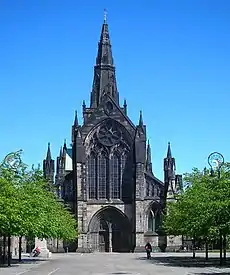 The front of Glasgow Cathedral, from Cathedral Square | |
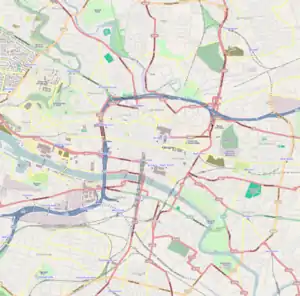 Glasgow Cathedral Location in central Glasgow | |
| 55°51′47″N 4°14′05″W | |
| Location | Glasgow |
| Country | Scotland |
| Denomination | Church of Scotland |
| Previous denomination | Roman Catholic (1137-1500s) |
| Website | www |
| History | |
| Status | Active |
| Dedication | Saint Mungo |
| Dedicated | 7 July 1136 |
| Architecture | |
| Functional status | High Kirk |
| Heritage designation | Category A Listed Building |
| Designated | 15 December 1970 |
| Architectural type | Church |
| Style | Gothic |
| Specifications | |
| Length | 87 m (285 ft 5 in) |
| Width | 20 m (65 ft 7 in) |
| Height | 32 m (105 ft 0 in) |
| Number of spires | 1 |
| Spire height | 68.6 m (225 ft 1 in) |
| Administration | |
| Presbytery | Glasgow |
| Clergy | |
| Minister(s) | Rev'd Mark E. Johnstone |
| Laity | |
| Director of music | Andrew Forbes |
| Organist(s) | Dr Malcolm Sim |
| Flower guild | Norma A Clarkson-Gorman |
Listed Building – Category A | |
| Designated | 15 December 1970 |
| Reference no. | LB32654 |
History
The history of the cathedral is linked with that of the city, and is allegedly located where the patron saint of Glasgow, Saint Mungo, built his church. The tomb of the saint is in the lower crypt. Walter Scott's novel Rob Roy gives an account of the kirk.
Built before the Reformation from the late 12th century onwards and serving as the seat of the Bishop and later the Archbishop of Glasgow, the building is a superb example of Scottish Gothic architecture.[3][4] It is also one of the few Scottish medieval churches (and the only medieval cathedral on the Scottish mainland) to have survived the Reformation not unroofed.
James IV ratified the treaty of Perpetual Peace with England at the high altar on 10 December 1502.[5] The cathedral and the nearby castle played a part in the battles of Glasgow in 1544 and 1560.[6] Twenty years after the Reformation, on 22 April 1581 James VI granted the income from a number of lands to Glasgow town for the kirk's upkeep. He traced the ownership of these lands to money left by Archbishop Gavin Dunbar as a legacy for repairing the cathedral.[7] The town council agreed on 27 February 1583 to take responsibility for repairing the kirk, while recording they had no obligation to do so.[8] The church survives because of this resolution. Inside, the rood screen is also a very rare survivor in Scottish churches.
The cathedral has been host to number of congregations and continues as a place of active Christian worship, hosting a Church of Scotland congregation. The current minister (since April 2019) is the Rev Mark E. Johnstone DL MA BD, who was previously minister at St. Mary's Church, Kirkintilloch. The building itself is in the ownership of The Crown, is maintained by Historic Scotland, and is a popular destination for tourists.
University of Glasgow
The University of Glasgow originated in classes held within the precinct of the cathedral. William Turnbull, Bishop of Glasgow was primarily responsible for the foundation of the university around the year 1451. In 1460, the university moved out of the cathedral to an adjacent site on the east side of the High Street, known locally as the college, and moved to its current home on Gilmorehill in 1870.
Music
Glasgow Cathedral Choir is a professional adult ensemble, singing at the two regular Sunday services each week. The current director of music is Andrew Forbes and the cathedral organist is Malcolm Sim. The four-manual Father Willis organ was installed in 1879, and has been maintained by Harrison & Harrison since they rebuilt the instrument in 1996.
Directors of Music
- 1879 Alfred Peace
- 1897 Herbert Walton
- 1929 R H Clifford Smith
- 1936 Wilfred J Emery
- 1965 John Turner
- 2010 Ian Simcock
- 2012 Richard Pratt
- 2014 Andrew Forbes
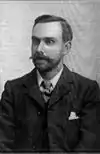
Other cathedrals in Glasgow
Other cathedrals in Glasgow are St. Andrew's Cathedral (Roman Catholic), St. Mary's Cathedral (Scottish Episcopal) and St Luke's Cathedral (Greek Orthodox).
List of ministers
- Archibald Inglis (1685–1687)
- Ralph Rodger (1687–1689)
- James Brown (1690–1714)
- George Campbell (1715–1748)
- John Hamilton (1749–1780)
- William Taylor (1780–1823)
- Duncan Macfarlan (1824–1857)
- John Robertson (1858–1865)
- George Stewart Burns (1865–1896)
- Pearson McAdam Muir (1896–1915)
- James McGibbon (1916–1922)
- Lauchlan Maclean Watt (1923–1934)
- Nevile Davidson (1935–1967)
- William Morris (1967–2005)
- Laurence A. B. Whitley (2007–2017)
- Mark E. Johnstone (2019–present)
Other burials
- John Anderson and his son John Anderson of Douhill, both 17th century Lord Provosts of Glasgow
- Robert Wishart, Catholic Bishop of Glasgow
- James Law, Episcopal Archbishop of Glasgow (1615–1632)
- Peter Lowe (surgeon), (1550-1610) doctor and medical author
- Charles Macintosh, inventor of the Mackintosh
- Peter Murdoch of Rosehill, Lord Provost 1730-1732
- Rev Prof George Jardine (1742-1827)
Gallery
 Cathedral with Cathedral Square
Cathedral with Cathedral Square Cathedral viewed from the pulpit, Cathedral Square
Cathedral viewed from the pulpit, Cathedral Square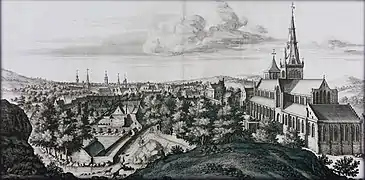 Cathedral engraving by John Slezer, (1693)
Cathedral engraving by John Slezer, (1693)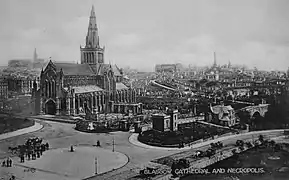 An old postcard view of the cathedral (1893)
An old postcard view of the cathedral (1893)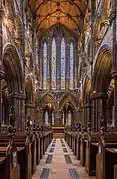 Glasgow Cathedral choir
Glasgow Cathedral choir
 Rob Roy in the Crypt of Glasgow Cathedral (more accurately, the Lower Church of Glasgow Cathedral), by the Dalziel Brothers, after Sir Walter Scott's novel, Rob Roy.
Rob Roy in the Crypt of Glasgow Cathedral (more accurately, the Lower Church of Glasgow Cathedral), by the Dalziel Brothers, after Sir Walter Scott's novel, Rob Roy.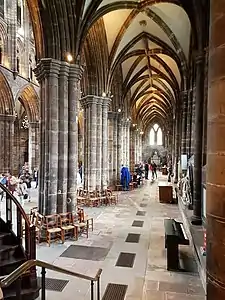 Cathedral interior from side, Cathedral Square
Cathedral interior from side, Cathedral Square
References
- https://www.historicenvironment.scot/visit-a-place/places/glasgow-cathedral/
- http://www.glasgowcathedral.org.uk/
- Architecture of Glasgow, by Andor Gomme and David Walker, published in 1968
- The Buildings of Scotland: Glasgow, by Elizabeth Williamson and others, published in 1990
- Bain, Joseph, ed., Calendar of Documents relating to Scotland, 1357–1509, vol. 4, HM Register House, Edinburgh (1888), p.339, nos.1690–2
- Dickinson, Gladys, ed., Two Missions of de la Brosse, SHS (1942), 81, 85–87
- Register of the Privy Council of Scotland, vol. 8, HMSO (1982), 38–39, no. 232.
- Extracts from the Burgh Records of Glasgow, (1876), 100.
External links
| Wikimedia Commons has media related to Glasgow Cathedral. |
- Official site of Glasgow Cathedral
- Historic Environment Scotland. "Glasgow Cathedral, precinct and graveyard (SM90150)".
- Historic Environment Scotland. "Glasgow Cathedral, excluding scheduled monument SM90150, 70 Cathedral Square, Glasgow (LB32654)".
- Glasgow Cathedral Precinct – History and original drawings of the Cathedral area.
- Glasgow Cathedral – from Virtual Scotland
- Glasgow Cathedral Photographs